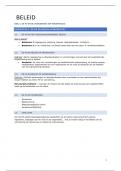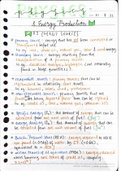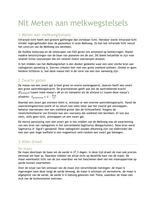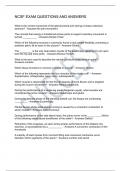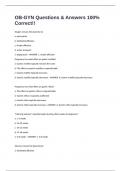2.3 Problem 3: Birth of Psychology
Understanding the Brain & Nervous System
Gall
Localization of function = functions located in particular regions of brain
Assumed that well-developed faculties in the brain would correspond with well-
developed parts of the brain. ‘Organs’ corresponding to well-developed faculties in
brain would be larger than organs corresponding to less-developed faculties, size
registered on skull as bumps
// pseudoscience; focused on bumps on brain rather than introspection
Nativistic; compared humans w/other animals
Behaviouristic rather than introspectionistic
Psychology of individual differences – rejected idea of generalizing
Phrenology = conformation of the skull as indicative of mental faculties & traits of
character
Donders
Time between stimulus & response could quantify speed of mental processes
Simple reaction time = turning on small light bulb above a response key
Compound reaction time = two lights & two keys. Subject must discriminate, make
judgment, about which light has come on and respond
If compound reaction is longer than simple, then mental action of judgment takes
longer
This is called mental chronometry
E.g., Stroop task: simple reaction time when congruent, compound reaction time
when incongruent
Psychophysics
Fechner: founder of experimental psychology
Carried out first research in experimental psychology
Saw that consciousness can be manipulated by controlling stimuli to which person is
exposed to
Non-linear relationship between psychological sensation & physical intensity
Weber-Fechner law:
JND between 2 stimuli varies in direct proportion to size of stimuli (s)
Constant = JND/s
When stimulus size becomes larger, JND is larger (more difficult to discriminate)
E.g., dot illustrations – harder to distinguish between 110 & 120 vs. 10 & 20
Francis Galton
- Wanted to measure intelligence
- Developed correlation coefficient = Pearson product-moment correlation
- Found strong correlation among exam grades = intelligence is a single mental ability
, - Controversy over general intelligence;
Galton: most intelligence = psychometric factor, g
Critics: intelligence = lots of skills, intelligences
- Measures of sensory acuity = measure of intelligence
- Size of head = measure of intelligence
- // His tests of intelligence were failures. Sensory acuity is not basis of intelligence,
and correlation between brain size & intelligence is small
The Spirit of Darwinian Psychology: Francis Galton
- Wanted to focus on improving human species eugenics, selective breeding
Wilhelm Wundt’s Psychology of Consciousness
Father of Psychology
Principle of Physiological Psychology: “an alliance between two sciences”
1) Physiology: “informs us about those life phenomena that we perceive by our
external senses”
2) Psychology: “the person looks upon himself from within”
Result = physiological psychology
By insisting nervous system is basis of all mentality, and by defining psych as
investigation of physiological conditions of conscious events, new field of
physiological psychology could establish itself as a science
Investigated through experiments, focused on normal mind
Trained subjects
Study the building blocks of the mind
Psychology as study of conscious experiences
Method of introspection
Wundt’s 2 systems of psychology: Heidelberg & Leipzig
Heidelberg program psychology = natural science, experimental method – bc
psychology is more than an extension of science. Focus on unconscious
Leipzig ‘spiritual science’ – different from natural science, so different way of
researching
Eventually rejected his Heidelberg system
Research Methods for Psychology
Introspection
Science of consciousness could only be based on objective, replicable results based on
standardized conditions capable of duplication & systematic variation
‘Internal perception’ traditional, prescientific method of armchair subjective
introspection. Uncontrolled, can’t hope to yield results useful to a scientific
psychology
‘Experimental self-observation’ Wundt preferred, scientifically valid form of
introspection where ‘observers’ are exposed to standard, repeatable situations, asked
to describe resulting experience
Understanding the Brain & Nervous System
Gall
Localization of function = functions located in particular regions of brain
Assumed that well-developed faculties in the brain would correspond with well-
developed parts of the brain. ‘Organs’ corresponding to well-developed faculties in
brain would be larger than organs corresponding to less-developed faculties, size
registered on skull as bumps
// pseudoscience; focused on bumps on brain rather than introspection
Nativistic; compared humans w/other animals
Behaviouristic rather than introspectionistic
Psychology of individual differences – rejected idea of generalizing
Phrenology = conformation of the skull as indicative of mental faculties & traits of
character
Donders
Time between stimulus & response could quantify speed of mental processes
Simple reaction time = turning on small light bulb above a response key
Compound reaction time = two lights & two keys. Subject must discriminate, make
judgment, about which light has come on and respond
If compound reaction is longer than simple, then mental action of judgment takes
longer
This is called mental chronometry
E.g., Stroop task: simple reaction time when congruent, compound reaction time
when incongruent
Psychophysics
Fechner: founder of experimental psychology
Carried out first research in experimental psychology
Saw that consciousness can be manipulated by controlling stimuli to which person is
exposed to
Non-linear relationship between psychological sensation & physical intensity
Weber-Fechner law:
JND between 2 stimuli varies in direct proportion to size of stimuli (s)
Constant = JND/s
When stimulus size becomes larger, JND is larger (more difficult to discriminate)
E.g., dot illustrations – harder to distinguish between 110 & 120 vs. 10 & 20
Francis Galton
- Wanted to measure intelligence
- Developed correlation coefficient = Pearson product-moment correlation
- Found strong correlation among exam grades = intelligence is a single mental ability
, - Controversy over general intelligence;
Galton: most intelligence = psychometric factor, g
Critics: intelligence = lots of skills, intelligences
- Measures of sensory acuity = measure of intelligence
- Size of head = measure of intelligence
- // His tests of intelligence were failures. Sensory acuity is not basis of intelligence,
and correlation between brain size & intelligence is small
The Spirit of Darwinian Psychology: Francis Galton
- Wanted to focus on improving human species eugenics, selective breeding
Wilhelm Wundt’s Psychology of Consciousness
Father of Psychology
Principle of Physiological Psychology: “an alliance between two sciences”
1) Physiology: “informs us about those life phenomena that we perceive by our
external senses”
2) Psychology: “the person looks upon himself from within”
Result = physiological psychology
By insisting nervous system is basis of all mentality, and by defining psych as
investigation of physiological conditions of conscious events, new field of
physiological psychology could establish itself as a science
Investigated through experiments, focused on normal mind
Trained subjects
Study the building blocks of the mind
Psychology as study of conscious experiences
Method of introspection
Wundt’s 2 systems of psychology: Heidelberg & Leipzig
Heidelberg program psychology = natural science, experimental method – bc
psychology is more than an extension of science. Focus on unconscious
Leipzig ‘spiritual science’ – different from natural science, so different way of
researching
Eventually rejected his Heidelberg system
Research Methods for Psychology
Introspection
Science of consciousness could only be based on objective, replicable results based on
standardized conditions capable of duplication & systematic variation
‘Internal perception’ traditional, prescientific method of armchair subjective
introspection. Uncontrolled, can’t hope to yield results useful to a scientific
psychology
‘Experimental self-observation’ Wundt preferred, scientifically valid form of
introspection where ‘observers’ are exposed to standard, repeatable situations, asked
to describe resulting experience

